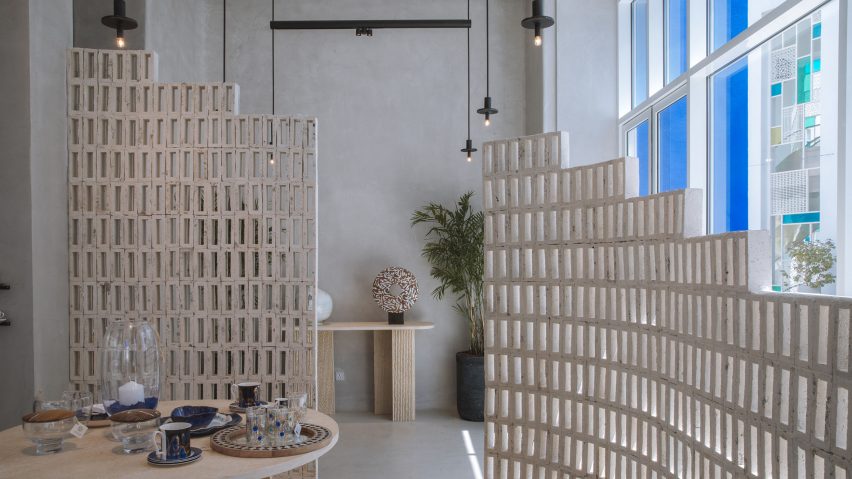Passive cooling techniques in architecture, reflective paint and water-filled windows are featured among the methods that designers and architects are using to mitigate heat in energy-efficient ways.
With a summer featuring record-breaking temperatures across the globe, we have gathered eight public and residential projects that use integrated cooling to provide much-needed relief from the heat.
From a giant, photovoltaic arch in Houston, to wind-catching towers in West Africa, these projects use a variety of methods to provide shade, cool ambient temperatures, and reduce humidity to keep inhabitants happy.
Last year, Dezeen contributor Smith Mordak highlighted 10 principles for designing cool spaces for hot weather and many of the following projects utilise them.
Read on to see eight projects featuring heat mitigation techniques.
Lycée Schorge Secondary School, Burkina Faso, by Diébédo Francis Kéré
Ventilation towers located above classrooms in this secondary school in Burkina Faso capture passing breezes and funnel them to the spaces below. Additionally, warm air rises through the towers and escapes through apertures created by the undulating, vaulted roofs.
Designed by architect Diébédo Francis Kéré, Lycée Schorge Secondary School also features an overhanging white-plaster coated roof, which helps provide shade and protects the interiors from direct sunlight.
Read more about Lycée Secondary School ›
Water House 2.o, Taiwan, by Water-Filled Glass
British startup Water-Filled Glass developed panes of glass filled with a thin layer of water that absorb radiant heat from the sun, and through a pump system, distribute the heat into different parts of a building or into thermal storage in order to cool a space.
Led by Matyas Gutai and colleagues Daniel Schinagl and Abolfazl Ganji Kheybari of Loughborough University, the team hopes the technology will provide a more sustainable heating and cooling system for heavily glazed buildings.
Read more about Water-Filled Glass›
Arch of Time (Arco del Tiempo), Texas, by Riccardo Mariano
Created by artist Riccardo Mariano, the Arch of Time in Houston, Texas, provides shade for the surrounding neighbourhood while also generating electricity to neighbouring buildings through integrated photovoltaic panels.
Circular apertures in the roof also mark the sun's movement across the sky, making this giant "sun-dial" a multi-use artwork for the public.
Read more about the Arch of Time›
GAF Cool Community Project, California, by GAF
American roofing firm GAF covered over 700,000 square feet (65,032 metres) of asphalt roads and public areas in Los Angeles with a propriety solar-reflective coating in order to mitigate the city's "heat island" effect, a problem that occurs in heavily paved neighbourhoods.
The company believes the coating may reduce surface temperatures by 10-12 degrees Fahrenheit (5.5-6.6 degrees Celsius).
GAF worked with local NGOs and city officials on the GAF Cool Community Project, which seeks to use the paints to cover recreational areas in brighter colours and roads in darker shades.
D/O Aqaba Bio-Brick, Jordan, by FADAA
Architecture studio FADAA created screens made of crushed shells in order to protect the interior of decor store D/O Aqaba from the harsh southern sun in Aqaba, Jordan.
The screens are made of stacked bio-bricks created using the shells of oysters, mussels, and clams left over from local seafood restaurants. The shells are crushed to form aggregate concrete and then pressed into a mould to form the hollow-brick shape.
Cañales Sports Complex, Mexico, by Quintanilla Arquitectos
Mexico City-based studio Quintanilla Arquitectos created a steel and concrete structure in order to shade a public sports complex in Cañales, Mexico.
"In a region of extreme heat and sun, shade is essential for the practice of indoor sports, in addition to ensuring thermal comfort," said the studio. Because of flooding in the area, durability was a main focus for the design.
Read more about the Cañales sports complex›
Flat House, England, Practice Architecture
London-based studio Practice Architecture integrated hempcrete into this pre-fabricated zero-carbon home in Cambridgeshire, England.
Hempcrete is a thermally efficient material that cools interiors by absorbing moisture from high-humidity air and lowering the relative humidity of a space.
The material also helps to maintain a consistent temperature within a house, which reduces the need for mechanical heating and cooling.
Australian Plant Bank, New South Wales, by BVN
The Australian Plant Bank by studio BVN employs an underground labyrinth in order to passively cool its upper, inhabited levels.
Warm air is captured, stored, and then cooled in the concrete walls of the labyrinth before it is circulated back into the building above.
Read more about the Australian Plant Bank ›

